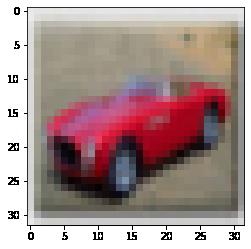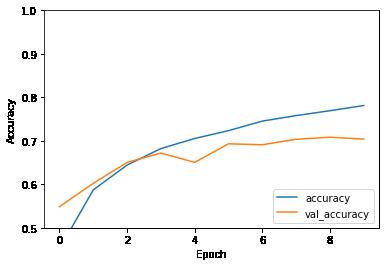tensorflow-彩色图像识别
Posted 老师我作业忘带了
tags:
篇首语:本文由小常识网(cha138.com)小编为大家整理,主要介绍了tensorflow-彩色图像识别相关的知识,希望对你有一定的参考价值。
- 🍨 本文为🔗365天深度学习训练营 中的学习记录博客
- 🍦 参考文章地址: 🔗深度学习100例-卷积神经网络(CNN)彩色图片分类
- 🍖 作者:K同学啊
本文做法与上一篇案例基本一模一样,算是复习了一下tensorflow解决简单分类问题的基本流程了。
设置GPU->导入数据->数据归一化->数据可视化->构建CNN网络->编译->训练模型->预测->模型评估。
一、前期工作
1、设置GPU
import tensorflow as tf
gpus = tf.config.list_physical_devices("GPU")
if gpus:
gpu0 = gpus[0] #如果有多个GPU,仅使用第0个GPU
tf.config.experimental.set_memory_growth(gpu0, True) #设置GPU显存用量按需使用
tf.config.set_visible_devices([gpu0],"GPU")2、导入数据
from tensorflow.keras import datasets, layers, models
import matplotlib.pyplot as plt
(train_images, train_labels), (test_images, test_labels) = datasets.cifar10.load_data()3、数据归一化
# 将像素的值标准化至0到1的区间内。
train_images, test_images = train_images / 255.0, test_images / 255.04、可视化
class_names = ['airplane', 'automobile', 'bird', 'cat', 'deer','dog', 'frog', 'horse', 'ship', 'truck']
plt.figure(figsize=(20,10))
for i in range(20):
plt.subplot(5,10,i+1)
plt.xticks([])
plt.yticks([])
plt.grid(False)
plt.imshow(train_images[i], cmap=plt.cm.binary)
plt.xlabel(class_names[train_labels[i][0]])
plt.show()
二、构建CNN网络
model = models.Sequential([
layers.Conv2D(32, (3, 3), activation='relu', input_shape=(32, 32, 3)), #卷积层1,卷积核3*3
layers.MaxPooling2D((2, 2)), #池化层1,2*2采样
layers.Conv2D(64, (3, 3), activation='relu'), #卷积层2,卷积核3*3
layers.MaxPooling2D((2, 2)), #池化层2,2*2采样
layers.Conv2D(64, (3, 3), activation='relu'), #卷积层3,卷积核3*3
layers.Flatten(), #Flatten层,连接卷积层与全连接层
layers.Dense(64, activation='relu'), #全连接层,特征进一步提取
layers.Dense(10) #输出层,输出预期结果
])
model.summary() # 打印网络结构三、编译
model.compile(optimizer='adam',
loss=tf.keras.losses.SparseCategoricalCrossentropy(from_logits=True),
metrics=['accuracy'])四、训练模型
history = model.fit(train_images, train_labels, epochs=10,
validation_data=(test_images, test_labels))五、预测
plt.imshow(test_images[1234])
import numpy as np
pre = model.predict(test_images)
print(class_names[np.argmax(pre[1234])])
六、模型评估
import matplotlib.pyplot as plt
plt.plot(history.history['accuracy'], label='accuracy')
plt.plot(history.history['val_accuracy'], label = 'val_accuracy')
plt.xlabel('Epoch')
plt.ylabel('Accuracy')
plt.ylim([0.5, 1])
plt.legend(loc='lower right')
plt.show()
test_loss, test_acc = model.evaluate(test_images, test_labels, verbose=2)
313/313 - 1s - loss: 0.8676 - accuracy: 0.7040 - 1s/epoch - 4ms/step
print(test_acc)0.7039999961853027
以上是关于tensorflow-彩色图像识别的主要内容,如果未能解决你的问题,请参考以下文章